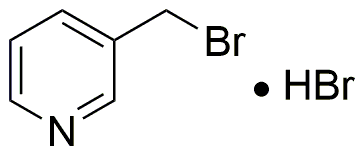3-(Bromomethyl)pyridine hydrobromide is widely utilized in research focused on:
- Synthesis of Pharmaceuticals: This compound serves as an important intermediate in the synthesis of various pharmaceuticals, particularly in the development of drugs targeting neurological disorders.
- Organic Synthesis: It is commonly used in organic chemistry for the preparation of pyridine derivatives, which are valuable in creating agrochemicals and fine chemicals.
- Research in Material Science: The compound is applied in the development of novel materials, including polymers and coatings, enhancing their properties through functionalization.
- Biological Studies: Researchers utilize it in biological assays to study interactions with proteins and enzymes, aiding in the discovery of new biochemical pathways.
- Ligand Development: It plays a role in the creation of ligands for metal complexes, which are essential in catalysis and various industrial processes.
General Information
Properties
Safety and Regulations
Applications
3-(Bromomethyl)pyridine hydrobromide is widely utilized in research focused on:
- Synthesis of Pharmaceuticals: This compound serves as an important intermediate in the synthesis of various pharmaceuticals, particularly in the development of drugs targeting neurological disorders.
- Organic Synthesis: It is commonly used in organic chemistry for the preparation of pyridine derivatives, which are valuable in creating agrochemicals and fine chemicals.
- Research in Material Science: The compound is applied in the development of novel materials, including polymers and coatings, enhancing their properties through functionalization.
- Biological Studies: Researchers utilize it in biological assays to study interactions with proteins and enzymes, aiding in the discovery of new biochemical pathways.
- Ligand Development: It plays a role in the creation of ligands for metal complexes, which are essential in catalysis and various industrial processes.
Documents
Safety Data Sheets (SDS)
The SDS provides comprehensive safety information on handling, storage, and disposal of the product.
Product Specification (PS)
The PS provides a comprehensive breakdown of the product’s properties, including chemical composition, physical state, purity, and storage requirements. It also details acceptable quality ranges and the product's intended applications.
Certificates of Analysis (COA)
Search for Certificates of Analysis (COA) by entering the products Lot Number. Lot and Batch Numbers can be found on a product’s label following the words ‘Lot’ or ‘Batch’.
*Catalog Number
*Lot Number
Certificates Of Origin (COO)
This COO confirms the country where the product was manufactured, and also details the materials and components used in it and whether it is derived from natural, synthetic, or other specific sources. This certificate may be required for customs, trade, and regulatory compliance.
*Catalog Number
*Lot Number
Safety Data Sheets (SDS)
The SDS provides comprehensive safety information on handling, storage, and disposal of the product.
DownloadProduct Specification (PS)
The PS provides a comprehensive breakdown of the product’s properties, including chemical composition, physical state, purity, and storage requirements. It also details acceptable quality ranges and the product's intended applications.
DownloadCertificates of Analysis (COA)
Search for Certificates of Analysis (COA) by entering the products Lot Number. Lot and Batch Numbers can be found on a product’s label following the words ‘Lot’ or ‘Batch’.
*Catalog Number
*Lot Number
Certificates Of Origin (COO)
This COO confirms the country where the product was manufactured, and also details the materials and components used in it and whether it is derived from natural, synthetic, or other specific sources. This certificate may be required for customs, trade, and regulatory compliance.

